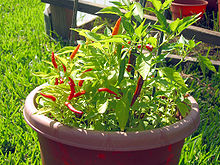Piri piri
Piri piri[1] is a cultivar of Capsicum frutescens from the malagueta pepper. It was originally produced in the Portuguese Empire. [2][3] It spread to other Portuguese places.
| Peri-Peri | |
|---|---|
 Peri-peri peppers (ripe red and unripe green) | |
| Genus | Capsicum |
| Species | Capsicum frutescens |
| Cultivar | Pili pili |
| Origin | Portuguese Empire |
| Heat | |
| Scoville scale | 50,000–175,000 SHU |
Plant characteristics
changePlants are usually very bushy and grow in height to 45–120 cm (18–47 in) with leaves 4–7 cm (1+1⁄2–3 in) long and 1.3–1.5 cm (1⁄2–9⁄16 in) wide. The fruits are generally tapered to a blunt point and measure up to 2–3 cm (3⁄4–1+1⁄4 in) long. The immature pod colour is green; the mature colour is bright red or purple. Some bird's-eye chili varieties measure up to 175,000 Scoville heat units.[4]
Cultivation
changePeri-peri is descended from plants from the Americas, but it has grown in the wild in Africa for centuries. It is now grown commercially in Zambia, Uganda, Malawi, Zimbabwe[5] and Rwanda. It grows mainly in Malawi, Ethiopia, Zambia, South Africa, Ghana, Nigeria, Zimbabwe, Mozambique and Portugal. It is cultivated for both commercial food processing and the pharmaceutical industry. Cultivation of peri-peri is labor-intensive.[5]
Peri-peri sauce
changePeri-peri sauce was produced by mixing pepper with condiments the Portuguese traded with their other territories in Asia and India.[6][7]
The sauce is made from peri-peri chilis used as a seasoning or marinade. Beyond Portugal and Southern African where it is very popular,[8] the sauce is particularly well known in the United Kingdom due to the success of the South African restaurant chain Nando's.
Some is used in cooking and some is used for seasoning at the table. The key ingredients are chili and garlic, with an oily or acidic base.[9][10][11]
Other common ingredients are salt, spirits (namely whisky), citrus peel, onion, pepper, bay leaves, paprika, pimiento, basil, oregano and tarragon.[12]
References
change- ↑ S.A, Priberam Informática. "Consulte o significado / definição de piripiri no Dicionário Priberam da Língua Portuguesa, o dicionário online de português contemporâneo". dicionario.priberam.org (in Brazilian Portuguese). Retrieved 2020-12-10.
- ↑ "It turns out you were learning to love peri-peri long before we ever had Nando's". The Independent. 2017-07-18. Archived from the original on 25 May 2022. Retrieved 2020-05-07.
- ↑ "History of Piri Piri Chicken". Food Fun Travel Blog. 2020-01-13. Retrieved 2020-05-07.
- ↑ "The Scoville scale". www.alimentarium.org. Retrieved 2019-02-20.
- ↑ 5.0 5.1 "Pepper Profile: African Birdseye". Fiery Foods and Barbecue SuperSite. Retrieved 27 December 2011.
- ↑ "Peri Peri Chicken: South Africa's Gift to the World". Nourishing Africa. Retrieved 2020-12-10.[permanent dead link]
- ↑ "Uncovering the origins of peri-peri sauce". Food. Retrieved 2020-12-10.
- ↑ Rowley Leigh, "A Fiery Challenge for Delicate Palates", The Financial Times, London, 25 September 2004, p. 6.
- ↑ Raghavan, Susheela (2006-10-23). Handbook of Spices, Seasonings, and Flavorings. doi:10.1201/b13597. ISBN 9780429129513.
- ↑ "Molho de piripiri". Vaqueiro PT (in European Portuguese). Retrieved 2021-03-08.
- ↑ "Piri piri sauce recipe from Lisbon by Rebecca Seal". Cooked. Retrieved 2021-03-08.[permanent dead link]
- ↑ Bender, David A., ed. (2009). "piri-piri". A Dictionary of Food and Nutrition. Oxford University Press. doi:10.1093/acref/9780199234875.001.0001. ISBN 9780199234875. Retrieved 24 February 2013.
Other websites
change- Media related to Capsicum frutescens 'Piri Piri' at Wikimedia Commons